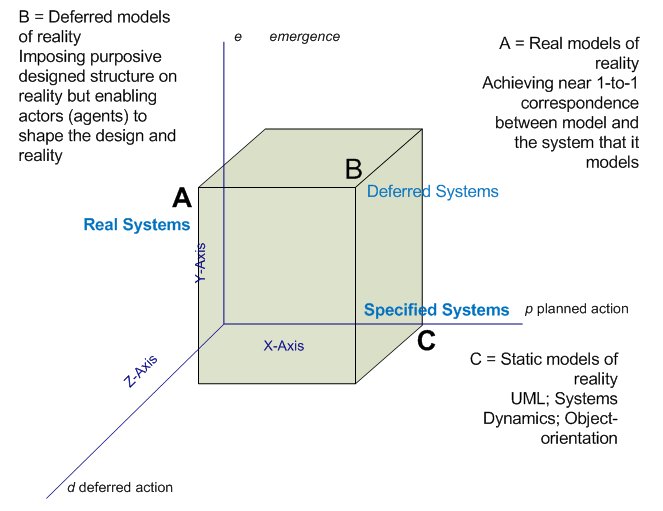Difference between revisions of "Deferred action, theory of"
m (1 revision: Dump from York) |
m (Text replace - "thumb|right|134px|[http://http://www.prin.edu// Site sponsor] thumb|right|134px|[http://www.yorku.ca/ Site sponsor]" to "") |
||
| Line 1: | Line 1: | ||
[[Image:AIS.jpg|thumb|right|134px|This site is associated with [http://www.aisworld.org/ AISWorld]]] | [[Image:AIS.jpg|thumb|right|134px|This site is associated with [http://www.aisworld.org/ AISWorld]]] | ||
| − | + | ||
| − | |||
== '''Theory of Deferred Action''' == | == '''Theory of Deferred Action''' == | ||
---- | ---- | ||
Revision as of 08:13, 26 October 2011
Theory of Deferred Action
Acronym
ToDA
Alternate name(s)
Deferred Action, Deferred Design, Deferred System
Main dependent construct(s)/factor(s)
Teleogical Design (Planned Action)
Main independent construct(s)/factor(s)
Deferred Action, Emergence
Concise description of theory
The theory of deferred action is a design and action theory, meaning that its purpose is to facilitate the design of IT artefacts that will be used by individuals and organisations to act purposefully or to achieve objectives. It assumes the possibility of bounded rational design of IT artefacts, including information systems. It recognises that such artefacts are used in social systems that are emergent. Since social systems are emergent, rationally designed IT artefacts need to grow along with emerging social systems. This growth is enabled by deferred design, the mechanism built into the IT artefact that permits actors, called active designers, to design the IT artefact in situ on an ongoing basis. The effect of emergence on rational design is called deferred action. Deferred action is the ability of actors to shape the IT artefact in live context. IT artefacts that are rationally designed to cope with emergent social systems are called deferred systems. The World Wide Web is a classic example. Technology that takes shape in live context is termed deferred technology.
Design principles: Principle of Underspecificaton, principle of ethics, Deferred Design Decisions Principle.
Diagram/schematic of theory
{Adapted from Patel, NV (2007) Deferred Action: Theoretical model of process architecture design for emergent business processes. Int. Journal of Business Science and Applied Management, Volume 2, Issue 3, pp. 4-21}
The diagram depicts the space of design and the main deferred action constructs. Design should be done along three meta-design dimensions planned action (rational design), emergence and deferred action or modalities. The dimensions are qualitative but a research aim is to develop measurement scales to provide quantaties to support design decisions. Since emeregence (e) is a constant of social systems it needs to be factored into planned action. This is done by enabling deferred action. The qualities of design, planned action, e , and deferred action, combined in different degrees result in the different design models of reality which are depicted as different implementable system types: real systems, deferred systems, and specified systems.
The contribution of the deferred model of information systems is the pursuit of teleological design in the context of emergent organisation. Deferred models impose purposive designed structure on reality, for example IS, but, crucially, enable actors to shape both the imposed design and reality in emergent context. Organisation structure and processes are stable to the extent that they can be planned and implemented. However, the effect of emergence means that the same structure and processes will need to change in response to emergent events. The consequence is that structure and processes are both predictable, when designed for teleological purpose, but unpredictable when affected by emergence. It is this predictableness and unpredictableness simultaneity that deferred action addresses and that planned action alone cannot cope.
Originating author(s)
Nandish V Patel
Seminal articles
Patel N V (2006) Organisation and Systems Design: Theory of Deferred Action. Palgrave Macmillan. Pp 253.
Patel N V (2009) The Theory of Deferred Action: Informing the design of information systems for complexity. In Dwivedi Y et al., (eds), Handbook of Research on Contemporary Theoretical Models in Information Systems, Information Science Reference (IGI Global), Hershey
Patel N V (2009) Theory of Deferred Action: Exploring the Boundaries of and Between Socio-Technical Systems Design. Design Principles & Practices: An International Journal, Vol 3.
Patel N V (2007) Deferred Action: Theoretical model of process architecture design for emergent business processes. Int. Journal of Business Science and Applied Management, Volume 2, Issue 3, pp. 4-21
Originating area
Information Systems
Level of analysis
System as interacted with by Individual, Group, Organisation, Society
IS articles that use the theory
Dron J (2005) "Epimethean information systems: harnessing the power of the collective in e-learning." Int. J. Information Technology and Management 4 (4): 392-404.
Elliman T and J Eatock (2005) "Online support for arbitration: designing software for a flexible business process." Int. J. Information Technology and Management 4 (4): 443-460.
Sotiropoulou, A. and Theotokis, D. (2005). Tailorable Information Systems: An Approach Based on Services and Service Composition. Int. J. Information Technology and Management. 4 (4): 366-391
Stamoulis, D. Kaneillis, P. Martakos, D. (2001). Tailorable Information Systems: Resolving the Deadlock of Changing User Requirements. Journal of Applied System Studies 2 (2).
Kaiya H and Kaijiri K (1999) "Refining Behavioural Specification for Satisfying Non-functional Requirements of Stakeholders." IEICE Trans. Fundamentals 82 (1) January.
Links from this theory to other theories
External links
Complexity theory at Sante Fe Institute http://www.santafe.edu/research/topics-living-systems-dynamics.php
Original Contributor(s)
Dr. Nandish V Patel, Brunel Business School, Brunel University, UK
Please feel free to make modifications to this site. In order to do so, you must register.
Return to Theories Used in IS Research
